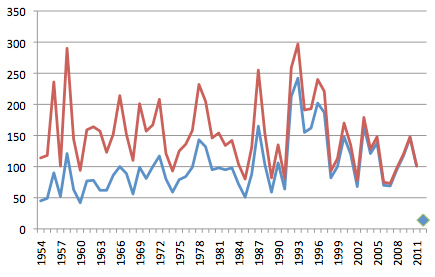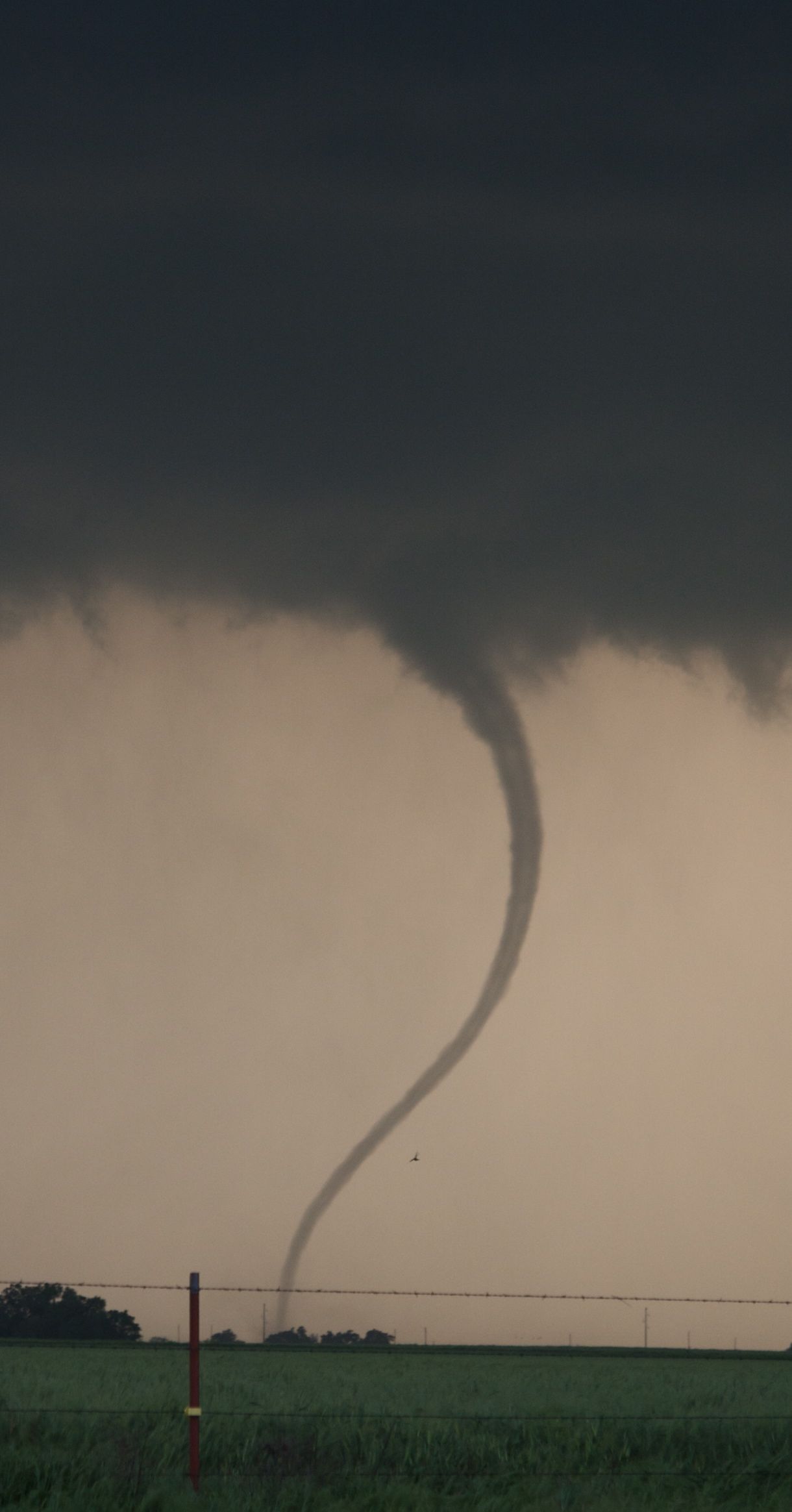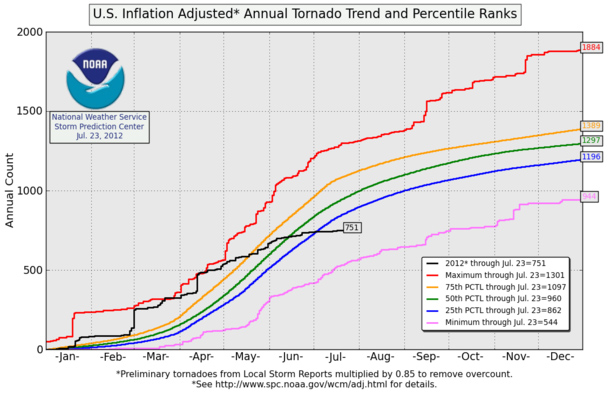Summertime, and the twisters are missin'
July heads for a record-low tornado count
Jul 24, 2012 - by Staff
Jul 24, 2012 - by Staff
Bob Henson | July 24, 2012 • Heat and drought are punishing much of the United States right now, but there’s actually some good weather news to report. This month is on track to produce fewer tornadoes than any July on record, and by a long shot.
As of July 23, this month has produced a paltry total of 14 tornado reports, according to preliminary data from NOAA’s Storm Prediction Center (SPC). While there could be more twisters before month’s end, a major outbreak doesn’t appear likely at all.
Update (August 1): The preliminary total of U.S. tornadoes for July 2012 is 24, according to NOAA's Harold Brooks. As noted by Climate Central, the Canadian province of Saskatchewan reported more tornadoes in July than the 48 contiguous U.S. states.
The chart below shows just how unusual this month has been, compared to past Julys. Graphed in blue are the final July tornado counts from the 1950s (when modern records began) to 2011. The next-most-quiet July after 2012 is 1960, which saw a total of 42 tornadoes—three times what we’ve seen thus far this month. Many Julys have produced more than 100 twisters.

The number of U.S. tornadoes reported each July (blue line) has gradually risen since the 1950s, with more observers and cameras watching the skies. The red line shows an estimate of how many tornadoes might have been observed if modern observing technologies and practices were in place throughout the entire period. The blue diamond at lower right shows this year’s July total: a mere 14 tornadoes, as of the 23rd of the month. (Data courtesy Harold Brooks, NOAA Storm Prediction Center; illustration by Wes Shifrin, © UCAR.)
The results get even more interesting when you adjust the numbers for “report inflation.” Tornado reports have gradually increased since the 1950s, especially for weak twisters. This appears to be a byproduct of the steady growth of interest in storm spotting and tornado chasing, along with the advent of inexpensive, high-quality digital photo and video tools. The attention and technology have combined to boost the reported numbers of weak tornadoes, whereas the strongest ones are being observed about as often as they were 50 or 60 years ago—a clue that it’s observing practice rather than climate change behind the trend.
Shown in red are the tornado counts as adjusted for report inflation by Harold Brooks (National Severe Storms Laboratory) and Greg Carbin (SPC). This procedure boosts the numbers in earlier years to replicate what might have been observed if Twitter, smartphones, and chase tours had been around at the time. The adjustment is smaller for more recent years, zeroing out for the current year. What this means is that the dearth of tornadoes in July 2012 becomes still more impressive. In the adjusted data, the quietest July is 2007, with 73 tornadoes—more than five times the current total for this month.

One of the country’s most active tornado days of 2012 was April 14, when 153 twisters were reported, including this one near Cherokee, Oklahoma. Since that date, tornadic activity has run far below average. (Photo © Bob Henson.)
In fact, this month could end up producing fewer tornadoes than any month on record for meteorological summer (June, July, and August). Among these, the old record is 20, set in August 1957. The inflation-adjusted number for that month would be 39.
What’s going on? Clearly, this month’s vanishing act is related to the intense ongoing drought, which is the nation’s most widespread since the 1950s. If thunderstorms aren’t happening, you can’t get a tornado—but not all thunderstorms can produce twisters. Violent tornadoes, in particular, need a complex blend of upper-level winds, unstable air near the ground, and other ingredients still being studied. This month, where thunderstorms have managed to form, they’ve been largely of the scattered, "air mass” variety, driven by local instability and limited by the lack of strong upper-level winds.
The drought’s onset this spring is mirrored in the rapid dropoff of tornado activity shown in the inflation-adjusted graphic at the bottom of this page. After a spate of deadly twisters in early April, tornado counts were at near-record highs for the time of year. After that point, activity plummeted, and 2012 is now in the bottom quarter of years, as ranked by total tornadic activity through mid-July.
Interestingly, prior to 2012, the three most tornado-starved Julys in the adjusted data are 2002, 2006, and 2007. Both 2002 and 2006 were among the nation's warmest 10 Julys in the last century, just as this one is shaping up to be. When a summer month is unusually hot, it generally means the polar jet stream has been shunted well to the north by domes of high pressure. That means less upper-level energy to fuel tornadic thunderstorms. Nontornadic storms (which rely less on wind shear and more on heat and moisture) may still pop up, assuming drought hasn’t taken hold.
Even without taking inflation into account, there’s no doubt tornadoes have been remarkably scant this month. For residents of the U.S. heartland, where the drought and heat are laying waste to crops and yards, that's at least something to be grateful for.

This “inflation-adjusted” graphic shows the progress of tornado reports for this year (black line) as compared to the highest (red) and lowest (magenta) accumulated totals for each day of the year, going back to 1954. By mid-April, around 500 tornadoes had already been reported—close to a record number. Tornado activity dropped off rapidly through the rest of the spring and early summer, as drought began gripping much of the central and eastern United States. The current total puts 2012 among the 25% of years with the least tornado activity (blue line). (Illustration courtesy NOAA Storm Prediction Center.)